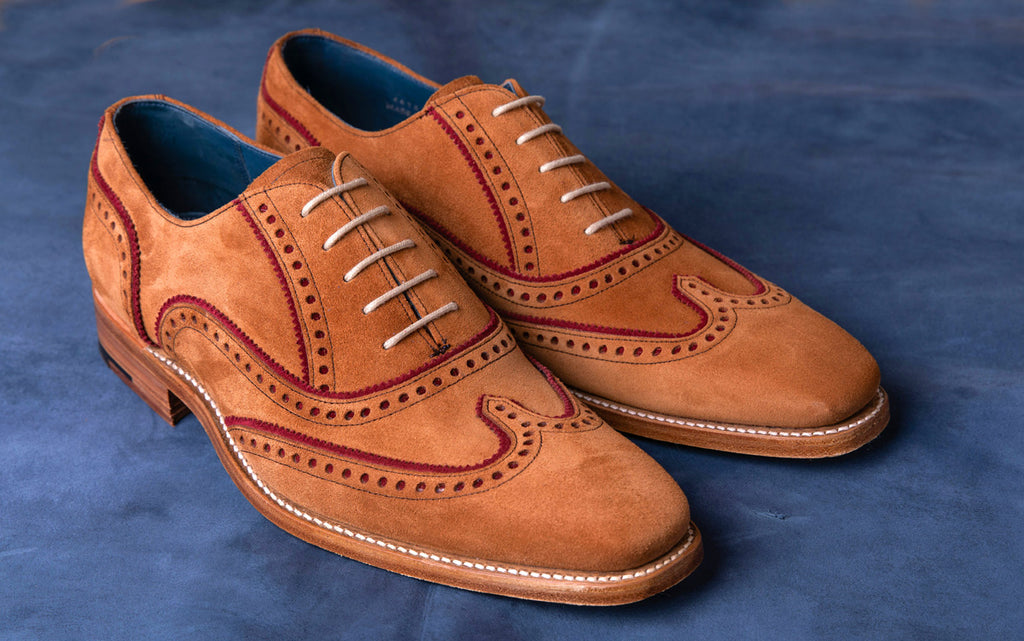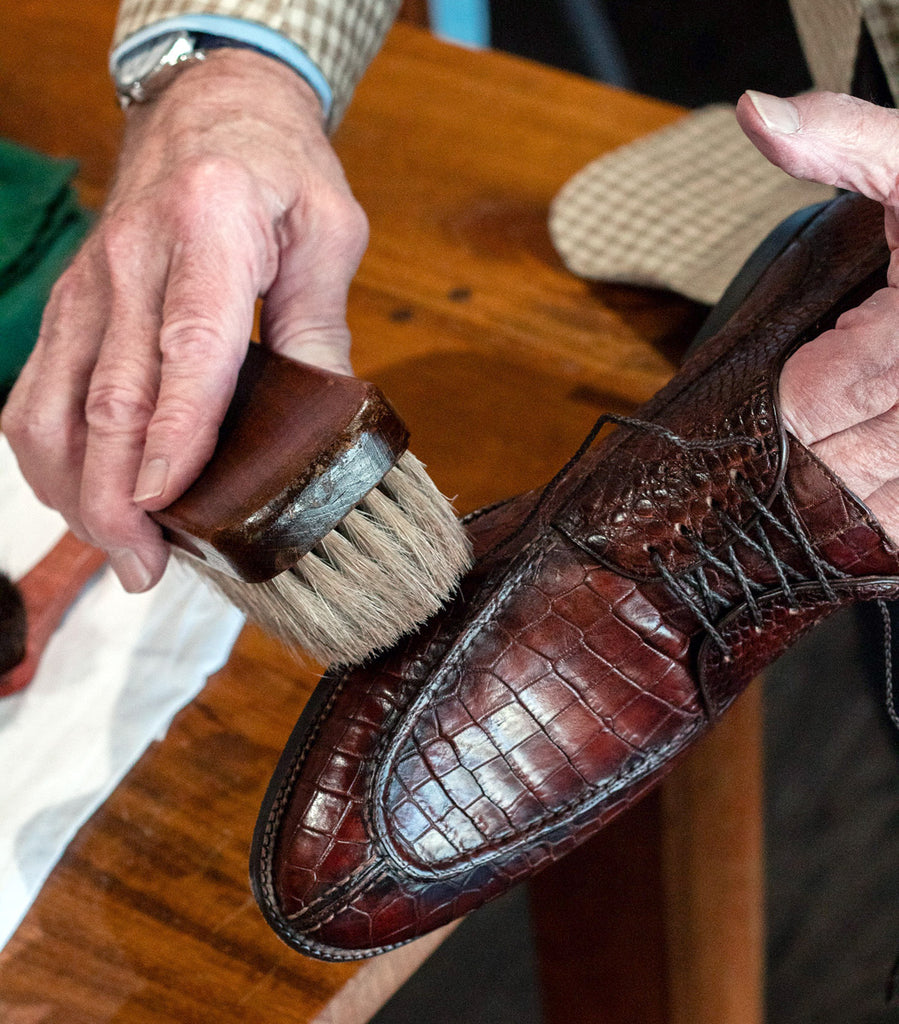Preserving Elegance: A Complete Guide on How to Clean & Care for Your Leather Shoes

Well-made leather footwear takes a gentleman’s style and comfort into equal consideration. But knowing how to clean and take care of your treasured leather shoes is a whole different story.
No matter if you wear your leather shoes daily, weekly, or every now and then for special occasions - they are an extension of both your wardrobe, and your feet! Taking care of them preserves both.
In this article, we’ll explore the types of leather most frequently used for footwear and address how to best care for leather shoes, including:
- Leather shoe maintenance
- How to properly clean leather shoes
- How to condition leather shoes
- How to polish leather shoes
- What shouldn’t be in your leather shoe care kit
- How to care for suede shoes
Popular Types of Shoe Leather
There are numerous types of leather, but only three are most frequently used to make men’s shoes: calfskin, suede, and patent.
When cared for properly, leather shoes that are worn daily typically last two to five years. Worn less often, they can last 10 or more years.
Calfskin leather is popular for good reason. It’s durable, highly versatile, and ages beautifully. Made from hide facing “out” – as in toward the animal’s hair – it has a smooth grain and supple surface.
Suede has a wonderful, naturally-derived velvety texture due to it being made from hide facing “in” – as in toward the animal’s flesh. Though also durable, it is more susceptible to water damage and staining, and the nap has the tendency to wear down from frequent use.

Patent leather is most often reserved for formal affairs and uniforms. Traditionally, patent leather is calf leather that has been treated in order to yield its telltale high-gloss finish. More common these days however you'll find faux leather that’s coated with a glossy plastic which, unlike the real deal, is prone to creasing and cracking.
While not leather, artificial leather is worth mentioning here due to its widespread use in modern footwear. Also known as vegan leather, synthetic leather, pleather or naugahyde, it can be made from recycled plastic, polyurethane, agricultural waste products (like cork, pineapple leaf, and apple peel), or from some combination therein.
Do Leather Shoes Need Maintenance?
Leather shoes can cost a pretty penny and, like all investments, should be taken care of accordingly. Doing so will protect their appearance, extend their shelf life, and safeguard the health of your feet.
The condition of the leather is important. When not in use, store your leather shoes in a cool, dry place away from direct sunlight. Use shoe trees to help maintain their shape and absorb excess moisture.
Knowing how to fix scuffed shoes and other basic repairs at home can save you money at the shoe repair shop, albeit perhaps only temporarily. Here are some how-tos you might consider:
Scuff marks that won’t yield to buffing may call for a leather repair kit. These kits typically include leather filler, color-matching compounds, and applicator tools to repair and restore damaged leather surfaces.
If the soles of your shoes are still in decent condition but you want to prevent further wear and tear, you can apply rubber sole protectors or traction pads.
For minor sole damage, you can use a strong adhesive to glue the sole back together. You can also try your hand at a DIY sole replacement kit.
In most cases, shoes are best surrendered to a cobbler for proper repair and restoration. They know how to repair leather shoes, stitching and patching the upper when feasible and mending or replacing heels and soles when needed.

How to Clean Leather Shoes
Knowing how to clean leather shoes at home correctly is important to ensuring you don't damage the material. Here's a step-by-step guide on how to clean and care for calfskin, patent and faux leather shoes effectively – we’ll touch on cleaning suede later.
1. Remove Dirt and DebrisTo help prevent scratching your shoes during the cleaning process, begin by using a soft brush or cloth to gently brush the surface of the shoes.
2. Prepare Cleaning Solution
Mix a leather cleaner or gentle dish soap with warm water. Make sure the soap is diluted properly to avoid leaving residue on the leather.
3. Test in an Inconspicuous Area
Before applying to the entire shoe, test it on an inconspicuous area to ensure it doesn't cause discoloration or damage to the leather.
4. Clean the Shoes
Dip a soft cloth or sponge into the cleaning solution and gently rub onto the shoes in a circular motion, focusing on areas with stains or dirt buildup. Excessive water can be damaging; do not soak the shoe.
5. Rinse
Use another clean cloth dampened with plain water to wipe away any soap residue.
6. Dry
Wipe with a microfiber cloth and air dry at room temperature. Avoid using a direct heat source like a hair dryer or heater, as they can cause the leather to crack or become stiff.

Should You Moisturize Leather Shoes?
Leather is a natural material that can dry out over time, especially with exposure to elements like sunlight, heat, and dry air. Moisturizing helps to replenish the natural oils in the leather, keeping it soft and flexible.
So yes, moisturizing leather shoes after you’ve cleaned and dried them is important to keep the leather supple. It also maintains the overall quality and appearance of the shoe.
Select a high-quality leather conditioner or cream specifically formulated for shoes. Avoid products containing silicone or petroleum-based ingredients, as they can create a sticky residue and may damage the leather over time. Look for products made with natural oils like lanolin, beeswax, or coconut oil.
Apply the conditioner with a clean, soft cloth or sponge in a gentle, circular motion, covering the entire surface evenly. Pay extra attention to areas that tend to get drier, such as creases or areas exposed to friction, and areas that are scuffed. Let it absorb into the leather for a few minutes, following the instructions provided with the product. This allows the leather to soak up the moisturizing agents effectively.
Depending on the condition of your leather shoes and how frequently you wear them, you may need to moisturize them every few months or as often as once a month. Pay attention to any signs of dryness or stiffness and moisturize as necessary to keep the leather in top condition.

How Do You Rehydrate Leather Shoes?
Shoes that look or feel stiff, dry, and cracked likely need a rehydrating treatment. Select a high-quality oil specifically designed for rehydrating leather, such as neatsfoot oil, mink oil, or coconut oil. They effectively penetrate the leather to replenish moisture without leaving a greasy residue.
Again, avoid silicone or petroleum-based products. And, as always, test in an inconspicuous area before applying the product to the entire shoe. Rehydrate your shoes using the same technique used when moisturizing them.
How to Buff and Polish Leather Shoes
When we think about cleaning leather shoes, we tend to picture polishing leather shoes. Buffing and polishing your leather shoes is considered optional, but we recommend taking the extra step.
Buffing your shoes with a clean cloth will remove any excess conditioner and restore shine. Applying a leather polish or cream after moisturizing will enhance the appearance and provide extra protection. For best results, choose a polish that matches the shoe color.

What Shouldn’t Be in Your Leather Shoe Care Kit?
Questions abound about how to clean leather shoes with household products. Specifically, Mop & Glo and Windex are cited as quick fixes for military footwear.
While you can use a mild dish soap to clean leather shoes, no other household cleaning agents should come into the picture.
Other unexpected products that might work include olive oil, the inside of a banana peel, and petroleum jelly. Try at your own risk!
How to Clean Suede Shoes
Cleaning suede requires a delicate touch to avoid damaging the material. By following these steps, you can effectively clean your suede shoes and keep them looking their best. If in doubt, consult a professional for advice and assistance.
1. Remove Dirt and DebrisUse a suede brush to gently brush away loose dirt or debris. Brush in the direction of the natural nap to avoid damaging the fibers.
2. Remove Stains and Scuff MarksGently rub the affected area with a suede eraser or a clean pencil eraser using light, circular motions to lift the stain without damaging the suede. For wet stains, blot the area immediately with a clean, dry cloth. Avoid rubbing, as it can spread the stain. (Don’t have a cloth? Sacrifice your sock to save your suede!)
3. Steam Clean (Optional)
Steam can clean soiled or stained suede. Hold the shoe over a pot of boiling water or use a handheld steam cleaner to gently steam the affected areas. Be careful not to get the suede too wet; use a clean cloth to blot away excess moisture.
For stubborn stains or overall cleaning, you can use a specifically formulated suede cleaner. Follow the instructions, allowing it to dry completely before brushing the suede.
5. Restore the Nap
After cleaning, use a suede brush to gently brush the entire surface in the direction of the nap. This helps to restore texture and appearance, and remove remaining dirt or residue.
6. Allow to Dry Properly
Allow your shoes to air dry naturally at room temperature, away from direct heat sources or sunlight. Stuff them with clean, dry paper towels to help them maintain their shape and absorb excess moisture during the drying process.
7. Spray with a Suede Protector
Once dry, consider applying a protective spray to help repel water, stains, and dirt and maintain the suede's appearance over time.
Your footwear can help you feel on top of the world! Show us your shoe game and favorite fine accessories – tag us with #RHanauer. We’re on Instagram and Facebook, and our social feeds are chock full of sartorial inspiration and exclusive looks behind the scenes.

